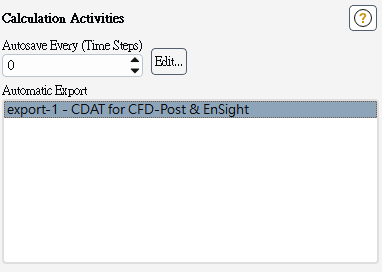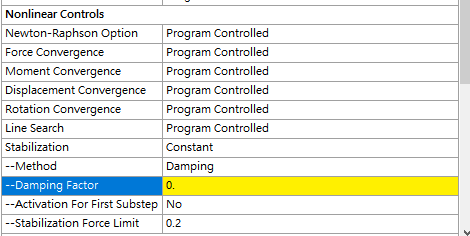-
-
January 7, 2025 at 3:43 am
idenyu8701
SubscriberHi everyone!
I am conducting a 2-way FSI simulation, where the fluid domain has an inlet velocity of 0.5 m/s. However, in the structural domain results, six deformation waves appear, which seems unreasonable. Ideally, the deformation should gradually increase over time instead of showing periodic waves.
Could anyone help identify which settings might be incorrect?

-
January 7, 2025 at 9:52 am
Rob
Forum ModeratorThe problem could be have any number of causes. Are all of the boundary conditions sensible, and similarly are material properties suitable?
-
January 10, 2025 at 5:27 am
idenyu8701
SubscriberHow can I ensure that the boundary conditions are reasonable?
For the fluid domain:
- Inlet velocity: 0.5 m/s
- Outlet: pressure outlet
- glycerin
For the structural domain:
- Object: a rectangular block
- Boundary condition: Fixed support at the bottom, while other surfaces are set as fluid-solid interface
Is this setup appropriate?
-
January 10, 2025 at 10:13 am
Rob
Forum Moderator0.1mm diameter(?) and 0.5m/s flow speed with glycerin (which is pretty viscous) will give a fairly high pressure drop along the tube. How rigid is the box?
-
January 13, 2025 at 9:40 am
idenyu8701
SubscriberMy fluid domain is 250 x 400 x 3000 mm, and the surrounding boundaries are set as walls.
The solid object's Young's modulus is set to 1.23 MPa, and its density is 1030 kg/m³.Based on your experience, how long would a fluid-structure interaction simulation like this typically take? Currently, I’ve only completed 1% in two days using the System Coupling module.
-
-
January 13, 2025 at 11:11 am
Rob
Forum ModeratorIt depends. The 1% report is of whatever you set to run, so that may or may not be 1% of what you need to run. You may need more cpu, or you may need to review the model settings.
-
January 13, 2025 at 1:57 pm
-
-
January 13, 2025 at 2:24 pm
Rob
Forum ModeratorProbably not, the solvers tend to use what they need. Checking with one of the Mech team - I can switch it on and make pretty pictures but that's about my limit!
-
January 13, 2025 at 2:50 pm
idenyu8701
SubscriberThank you so much!
The reason I’m using the System Coupling software is that the internal System Coupling solution doesn’t allow me to observe the desired physical quantities or the interactions between the structure and the fluid. Even after watching all the Ensight tutorial videos and learning the operation methods, I’m still facing issues.
So far, I’ve identified two potential problems:
- The physical time in Fluent, Mechanical, and System Coupling may not be synchronized with Ensight.
- I’ve seen suggestions on other websites about using the external System Coupling solver and utilizing the Automatic Export feature to read the solution data.
Do you have any suggestions?
-
-
January 13, 2025 at 3:02 pm
Rob
Forum ModeratorHaving checked, the periodic is likely due to a lack of damping in the structure: you're setting it up by accident and it should have some damping effect from the materials(?).
The memory error may or may not be solver/coupling or could be a result of RAM not clearing. A restart/reboot may resolve that.
-
January 13, 2025 at 4:06 pm
-
-
January 13, 2025 at 4:13 pm
Rob
Forum ModeratorPossibly - what does the manual say?
-
January 14, 2025 at 2:01 am
-
-
January 14, 2025 at 9:49 am
Paul Hutcheson
Ansys EmployeeHi,
I’ve joined this thread to help out on this FSI topic.
- Is your problem transient or steady? I guess transient.
- Why do you expect a gradual increase in deformation, rather than an oscillation? It’s quite common for structures with flow over them to oscillate at one of its natural frequencies. If you run a modal analysis on the structure probably you’d find one of the natural frequencies coinciding with this one from 2-way FSI. It’s called fluid induced vibration. I need to see the configuration, flow direction, shape of structure and where the supports are to understand better.
- What is the goal of the analysis?
1.23 MPa is an extremely small modulus – what material is it? Also the fluid and solid densities are similar. This could be a challenging FSI analysis with numerical stablity problems.
Paul
-
January 20, 2025 at 6:32 am
idenyu8701
SubscriberHi Paul, sorry for the delayed reply.
My issue indeed revolves around solving transient problems. The reason I initially expected the deformation to gradually increase is that the fluid settings involve glycerin with a velocity inlet of 0.5 m/s directed toward a gauge pressure outlet of 0. I am concerned that the simulation might have only applied the fluid forces to the structure once, even though the simulation completed successfully.
The goal of the analysis is to observe how a rectangular flexible structure deforms due to the pressure difference caused by fluid forces. Using FSI simulation, I aim to visualize the pressure changes.
In this setup, the bottom of the rectangular structure is set as a fixed support, while all other surfaces are defined as fluid-solid regions. The material properties are based on reference values: Young’s modulus of 1.23 MPa, Poisson’s ratio of 0.3, and density of 1030 kg/m³. For the fluid, glycerin is used.
I look forward to your reply as I am in great need of assistance.
-
January 21, 2025 at 3:37 pm
Paul Hutcheson
Ansys EmployeeI need more info on your coupling setup to know how often force is exchanged. If it's oscillating likely force is exchanged every iteration which is normal.
I don't see anything unusual in your results. If you want confidence in results you a reference solution and understand the physics better.
Run a modal analysis and compare the frequencies with the one from fsi.
Paul
-
- You must be logged in to reply to this topic.


- air flow in and out of computer case
- Varying Bond model parameters to mimic soil particle cohesion/stiction
- Eroded Mass due to Erosion of Soil Particles by Fluids
- Issue to compile a UDF in ANSYS Fluent
- Guidance needed for Conjugate Heat Transfer Analysis for a 3s3p Li-ion Battery
- JACOBI Convergence Issue in ANSYS AQWA
- affinity not set
- Resuming SAG Mill Simulation with New Particle Batch in Rocky
- Continuing SAG Mill Simulation with New Particle Batch in Rocky
- Is it able to solve turbomachinery using density-based solver in Fluent?

-
4527
-
1494
-
1386
-
1209
-
1021

© 2025 Copyright ANSYS, Inc. All rights reserved.











